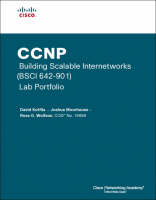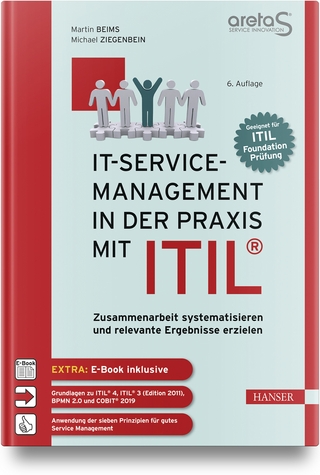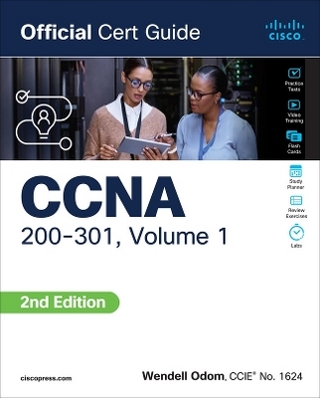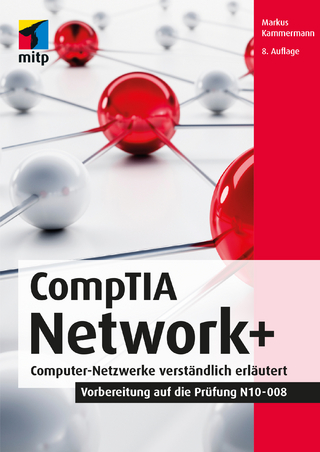
CCNP Building Scalable Internetworks (BSCI 642-901) Lab Portfolio (Cisco Networking Academy)
Cisco Press (Verlag)
978-1-58713-213-1 (ISBN)
- Titel ist leider vergriffen;
keine Neuauflage - Artikel merken
The labs reinforce your understanding of how to install, configure, monitor, and troubleshoot network infrastructure equipment. You will apply your knowledge of configuration of EIGRP, OSPF, IS-IS, and BGP routing protocols and how to manipulate and optimize routing updates between these protocols. Other topics covered include multicast routing, IPv6, and DHCP configuration.
Those preparing for the Building Scalable Cisco Internetworks (BSCI 642-901) certification exam should work through this book cover-to-cover. Or if you need to quickly review configuration examples, you can go directly to the relevant chapter.
CCNPBuildingScalable Internetworks (BSCI 642-901) Lab Portfolio includes
33 Labs built to support v5 of the Building Scalable Internetworks course within the Cisco® Networking Academy® curriculum providing ample opportunity to practice.
6 Challenge and Troubleshooting Labs have been added to the Lab Portfolio to further test your mastery of the topics.
4 Case Studies provide practice in planning, designing, and implementing EIGRP, OSPF, and BGP networks. Even if you do not have the actual equipment to configure these more complex topologies, it is worth reading through these labs to expand your thinking into more complex networking solutions.
By successfully completing the exercises in this book you will gain the experience necessary to use advanced IP addressing and routing in implementing scalability for Cisco integrated services routers (ISR) connected to LANs and WANs.
David Kotfila , CCNP, CCAI, is the Director of the Cisco Academy at Rensselaer PolytechnicInstitute (RPI), Troy, New York. Under his direction, 350 students have received their CCNA, 150 studentshave received their CCNP, and 8 students have obtained their CCIE. David is a consultant forCisco, working as a member of the CCNP assessment group. His team at RPI has authored the fournew CCNP lab books for the Academy program. David has served on the National Advisory Council for the Academy program for four years. Previously he was the Senior Training Manager at PSINet, a Tier 1 global Internet service provider. Joshua Moorhouse, CCNP, recently graduated from Rensselaer Polytechnic Institute (RPI) with a B.S. in Computer Science, where he also worked as a teaching assistant in the Cisco Networking Academy. He currently works as a network engineer at Factset Research Systems in Norwalk, Connecticut. Ross Wolfson, CCIE No. 16696, recently graduated from Rensselaer Polytechnic Institute (RPI) with a B.S. in Computer Science. He currently works as a network engineer at Factset Research Systems.
Chapter 1 Scalable Network Design 1
Lab 1-1: BSCI Lab Configuration Guide (1.5.1) 1
Lab 1-2: TCL Script Reference and Demonstration (1.5.1) 3
Quick TCL Reference 3
Step 1: Initial Configuration 4
Step 2: Verify Connectivity 5
Step 3: Resolve Connectivity Issues 10
Conclusion 14
Chapter 2 EIGRP 15
Lab 2-1: EIGRP Configuration, Bandwidth, and Adjacencies (2.7.1) 15
Scenario 15
Step 1: Addressing 16
Step 2: Configuring EIGRP Across VLAN1 17
Step 3: Verifying the EIGRP Configuration 19
Step 4: Configuring EIGRP on the Serial Interfaces 20
Step 5: Configuring Network Statement Wildcard Masks 22
Challenge: Topology Change 23
Lab 2-2: EIGRP Load Balancing (2.7.2) 26
Scenario 26
Step 1: Addressing and Serial Configuration 26
Step 2: EIGRP Configuration 29
Step 3: EIGRP Topology Table 32
Step 4: Equal-Cost Load Balancing 34
Step 5: Alternate EIGRP Paths Not in the Topology Table 35
Step 6: Unequal-Cost Load Balancing 38
Initial Configurations 45
TCL Script Output 47
Lab 2-3: Summarization and Default Network Advertisement (2.7.3) 53
Scenario 53
Step 1: Initial Configuration 54
Step 2: Summarization Analysis 57
Step 3: EIGRP Auto-Summarization 61
Step 4: EIGRP Manual Summarization 70
Step 5: Default Network Advertisement 72
Conclusion 77
TCL Script Output 79
Analyzing Major Networks 86
Lab 2-4: EIGRP Frame Relay Hub and Spoke: Router Used as Frame Switch (2.7.4) 89
Scenario 90
Step 1: Addressing 90
Step 2: Configuring the Frame Relay Switch 91
Step 3: Configuring the Frame Relay Endpoints 92
Step 4: Setting Interface-Level Bandwidth 94
Step 5: Configuring EIGRP 95
Step 6: Using Nonbroadcast EIGRP Mode 99
Step 7: Implementing EIGRP Manual Summarization 100
TCL Script Output 102
Lab 2-5: EIGRP Frame Relay Hub and Spoke: Adtran Used as Frame Switch (2.7.4) 110
Scenario 111
Step 1: Addressing 111
Step 2: Frame Relay Network 112
Step 3: Configuring the Frame Relay Endpoints 113
Step 4: Setting Interface-Level Bandwidth 114
Step 5: Configuring EIGRP 115
Step 6: Using Nonbroadcast EIGRP Mode 119
Step 7: Implementing EIGRP Manual Summarization 120
TCL Script Output 122
Lab 2-6: EIGRP Authentication and Timers (2.7.5) 131
Scenario 131
Step 1: Addressing 131
Step 2: Configuring Basic EIGRP 133
Step 3: Configuring Authentication Keys 134
Step 4: Configuring EIGRP Link Authentication 135
Step 5: Manipulating EIGRP Timers 139
TCL Script Output 142
Lab 2-7: EIGRP Challenge Lab (2.7.6) 147
Lab 2-8: EIGRP Troubleshooting Lab (2.7.7) 148
Initial Configurations 148
Chapter 3 OSPF 151
Lab 3-1: Single-Area OSPF Link Costs and Interface Priorities (3.11.1) 151
Scenario 151
Step 1: Addressing 152
Step 2: Adding Physical Interfaces to OSPF 153
Step 3: OSPF show Commands 154
Step 4: Adding Loopback Interfaces to OSPF 157
Step 5: Modifying Link Costs in OSPF 159
Step 6: Modifying Interface Priorities 161
Challenge: Topology Change 162
TCL Script Verification 163
Lab 3-2: Multiple-Area OSPF with Stub Areas and Authentication (3.11.2) 167
Scenario 167
Step 1: Addressing 167
Step 2: Adding Interfaces into OSPF 168
Step 3: Stub Areas 171
Step 4: Totally Stubby Areas 173
Step 5: Not So Stubby Areas 176
Step 6: OSPF Interface Authentication 181
TCL Script Output 182
Lab 3-3: OSPF Virtual Links and Area Summarization (3.11.3) 187
Scenario 187
Step 1: Addressing 188
Step 2: Adding Interfaces into OSPF 189
Step 3: Creating a Virtual Link 190
Step 4: Summarizing an Area 193
Step 5: Generating a Default Route into OSPF 195
Challenge: Configure OSPF Authentication 197
TCL Connectivity Verification 197
Lab 3-4: OSPF over Frame Relay Using a Router as the Frame Relay Switch (3.11.4a) 202
Scenario 203
Step 1: Addressing 203
Step 2: Setting Up NBMA OSPF 204
Step 3: Changing the Network Type to Point-to-Multipoint 205
Step 4: Changing OSPF Timers 207
Challenge: Minimal Hello Intervals 208
TCL Connectivity Verification 209
Lab 3-5: OSPF Over Frame Relay Using an Adtran as the Frame Relay Switch (3.11.4b) 213
Scenario 213
Step 1: Addressing 214
Step 2: Setting Up NBMA OSPF 215
Step 3: Changing the Network Type to Point-to-Multipoint 216
Step 4: Changing OSPF Timers 218
Challenge: Minimal Hello Intervals 219
TCL Connectivity Verification 220
Lab 3-6: OSPF Challenge Lab (3.11.5) 224
Lab 3-7: OSPF Troubleshooting Lab (3.11.6) 225
Initial Configurations 226
Chapter 4 IS-IS 229
Lab 4-1: Configuring Basic Integrated IS-IS (4.7.1) 229
Scenario 229
Step 1: Addressing and Basic Connectivity 230
Step 2: Configuring Basic IS-IS 230
Step 3: Verifying IS-IS Adjacencies and Operation 231
Step 4: Converting to the IS-IS Backbone 237
Step 5: Manipulating the IS-IS Interface Timers 239
Step 6: Implementing IS-IS L2 Core Authentication 240
Step 7: Implementing IS-IS Domain Authentication 241
TCL Script Output 243
Lab 4-2 Multi-Area Integrated IS-IS (4.7.2) 246
Scenario 246
Step 1: Addressing and Initial Configuration 246
Step 2: Verify IS-IS Initial Operation 247
Step 3: Configure IS-IS Area 2 248
Step 4: Verify IS-IS Multi-Area Operation 248
Step 5: Configure IS-IS Domain Authentication 250
Step 6: Reconfigure IS-IS Area 1 251
Step 7: Reconfigure R3 IS-IS Operation 254
Step 8: Verify IS-IS Intra-Area Operation 255
Reflection 257
TCL Script Output 257
Lab 4-3: Configuring IS-IS over Frame Relay: Router Used as Frame Switch (4.7.3a) 260
Scenario 261
Step 1: Addressing and Basic Configuration 261
Step 2: Frame Relay Configuration 261
Step 3: Configure and Verify IS-IS over Frame Relay 263
Step 4: Verify IS-IS Connectivity 265
Step 5: Demonstrate IS-IS Interface-Type Mismatch 265
Router as Frame Relay Switch Configuration 267
TCL Script Output 268
Lab 4-4: Configuring IS-IS over Frame Relay: Adtran Used as Frame Switch
(4.7.3b) 271
Scenario 271
Step 1: Addressing and Basic Configuration 271
Step 2: Frame Relay Configuration 272
Step 3: Configure and Verify IS-IS over Frame Relay 274
Step 4: Verify IS-IS Connectivity 276
Step 5: Demonstrate IS-IS Interface-Type Mismatch 276
TCL Script Output 278
Chapter 5 Route Optimization 281
Lab 5-1: Redistribution Between RIP and OSPF (5.6.1) 281
Scenario 282
Step 1: Assign Addresses 282
Step 2: Configure RIPv2 284
Step 3: Configure Passive Interfaces in RIP 286
Step 4: Summarize a Supernet with RIP 288
Step 5: Suppress Routes Using Prefix Lists 290
Step 6: Configure OSPF 292
Step 7: Configure Passive Interfaces in OSPF 293
Step 8: Allow One-Way Redistribution 295
Step 9: Redistribute Between Two Routing Protocols 297
Step 10: Set a Default Seed Metric 297
Step 11: Change the OSPF External Network Type 298
Challenge: Use Extended Access Lists for Filtering 299
TCL Script Output: Steps 8 and 9 300
Lab 5-2 Redistribution Between EIGRP and OSPF (5.6.2) 307
Scenario 307
Step 1: Additional Addressing 308
Step 2: Configuring EIGRP 308
Step 3: Create Passive Interfaces in EIGRP 309
Step 4: Manually Summarize with EIGRP 311
Step 5: Additional OSPF Configuration 312
Step 6: Summarize OSPF Areas at the ABR 314
Step 7: Mutually Redistribute Between OSPF and EIGRP 315
Step 8: Filter Redistribution with Route Maps 319
Step 9: Summarize External Routes into OSPF at the ASBR 320
Step 10: Modifying EIGRP Distances 321
Step 11: Modifying OSPF Distances 322
Challenge: Change Administrative Distance on R2 324
TCL Script Output 325
Exploring Black Hole Operation 333
Lab 5-3: Redistribution Between EIGRP and IS-IS (5.6.3) 337
Scenario 337
Step 1: Assign Addresses 338
Step 2: Configure EIGRP 339
Step 3: Configure IS-IS 340
Step 4: Mutually Redistribute Between IS-IS and EIGRP 342
Step 5: Filter Network Addresses with Route Maps 344
Step 6: Filter Prefixes with Route Maps 347
Step 7: Summarize Addresses in IS-IS 349
TCL Script Output 350
Lab 5-4: Manipulating Administrative Distances (5.6.4) 357
Scenario 357
Pre-Lab: Review of Administrative Distances 358
Step 1: Configure Addressing 358
Step 2: Configure RIP 359
Step 3: Configure OSPF 362
Step 4: Modify a Routing Protocol’s Distance 366
Step 5: Modify Distance Based on Route Source 368
Step 6: Modify Distance Based on an Access List 370
Challenge 373
Lab 5-5: Configuring the Cisco IOS DHCP Server (5.6.5) 374
Scenario 374
Step 1: Assign IP Addresses 374
Step 2: Configure EIGRP 375
Step 3: Configure a DHCP Pool 376
Step 4: Verify DHCP Lease on Client 379
Step 5: Verify DHCP Configuration on Server 380
Step 6: DHCPRELEASE and DHCPRENEW 381
Step 7: Configure the IP Helper Address 385
Challenge: Apply Per-Protocol Forwarding 386
Chapter 6 BGP 387
Lab 6-1: Configuring BGP with Default Routing (6.7.1) 387
Scenario 387
Step 1: Assign IP Addresses 387
Step 2: Configure the ISPs 388
Step 3: Configure SanJose BGP 388
Step 4: Verify BGP on the SanJose Router 389
Step 5: Filter Routes 390
Step 6: Configure the Primary and Backup Routes Using Floating Static
Routes 390
Step 7: Configure Primary and Backup Routes Using Static Routes 392
TCL Verification 395
Lab 6-2: Using the AS_PATH Attribute (6.7.2) 399
Scenario 399
Step 1: IP Addressing 399
Step 2: Configure BGP 400
Step 3: Remove the Private AS 400
Step 4: Use the AS_PATH Attribute to Filter Routes 401
TCL Output 402
Lab 6-3: Configuring IBGP and EBGP Sessions, Local Preference, and
MED (6.7.3) 406
Scenario 406
Step 1: IP Addressing 406
Step 2: Configure EIGRP 407
Step 3: Configure IBGP 407
Step 4: Verify BGP Neighbors 407
Step 5: Configure EBGP 407
Step 6: Verify BGP Neighbors 408
Step 7: View BGP Summary Output 408
Step 8: Verify Which Path Traffic Takes 408
Step 9: BGP Next-Hop_Self 412
Step 10: Set BGP Local Preference 414
Step 11: Set BGP MED 415
Step 12: Establish a Default Network 419
TCL Verification 420
Lab 6-4: BGP Route Reflectors and Route Filters (6.7.4) 425
Scenario 425
Step 1: Configure RIPv2 425
Step 2: IBGP Peers and Route Reflectors 426
Step 3: Inject an External Route into BGP 427
Step 4: Inject a Summary Address into BGP 428
TCL Verification 429
Chapter 7 IP Multicasting 433
Lab 7-1: Implementing IGMP and IGMP Snooping (7.5.1) 433
Scenario 433
Overview 433
Step 1: Configure Hosts on a LAN 434
Step 2: Subscribe Interfaces to Multicast Groups with IGMP 434
Step 3: Verify IGMP Snooping on the Switch 439
Step 4: Configure a Multicast-Enabled Router on the VLAN 440
Step 5: Verify Multicast Operation at Layer 2 443
Step 6: Verify IGMP Snooping 444
Step 7: Verify Multicast Operation at Layer 3 446
Lab 7-2: Routing IP Multicast with PIM Dense Mode (7.5.2) 447
Scenario 447
Step 1: Configure Addressing and Implement IGMP 448
Step 2: Configure EIGRP 451
Step 3: Implement PIM-DM 451
Step 4: Verify PIM Adjacencies 455
Step 5: Verify Multicast Routing Operation 458
Step 6: Verify PIM-DM Flood-and-Prune Behavior 463
Step 7: Explore the Multicast Routing Table 466
Challenge 468
TCL Script Output: Unicast 468
Lab 7-3: Routing IP Multicast with PIM Sparse Mode (7.5.3) 474
Scenario 474
Step 1: Load Initial Configurations 474
Step 3: Implement PIM-SM 478
Step 4: Verify PIM Adjacencies 483
Step 5: Verify Multicast Routing Operation 485
Step 6: Verify PIM-SM Registration and SPT Cutover 490
Conclusion 493
Lab 7-4: Routing IP Multicast with PIM Sparse-Dense Mode (7.5.4) 496
Scenario 496
Step 1: Configure Addressing and Implement IGMP 497
Step 2: Configure Single-Area OSPF 500
Step 3: Implement PIM Sparse-Dense Mode 500
Step 4: Configure PIM Auto-RP 505
Step 5: Verify the RP Mappings 509
Step 6: Verify Multicast Operation 511
Step 7: Explore Auto-RP Operation with Sparse-Dense Mode 513
Step 8: Verify the Operation of Dense-Mode Fallback 515
TCL Script Output 520
Chapter 8 IPv6 527
Lab 8-1: Configuring OSPF for IPv6 (8.7.1) 527
Scenario 527
Step 1: Configuring the Loopback Interfaces 527
Step 2: Configuring Static IPv6 Addresses 528
Step 3: Changing the Link-Local Address on an Interface 529
Step 4: Configuring EUI-64 Addresses 531
Step 5: Enabling IPv6 Routing and CEF 533
Step 6: Setting Up OSPFv3 533
Challenge: Summarizing OSPFv3 Areas 539
TCL Script Output 539
Lab 8-2: Using Manual IPv6 Tunnels (8.7.2) 544
Scenario 544
Step 1: Configure Loopbacks and Physical Interfaces 544
Step 2: Configure EIGRP 545
Step 3: Configure a Manual IPv6 Tunnel 545
Step 4: Configure OSPFv3 Over a Tunnel 546
TCL Script Output 547
Lab 8-3: Configuring 6to4 Tunnels (8.7.3) 552
Scenario 552
Step 1: Configure Loopbacks and Physical Interfaces 552
Step 2: Configure EIGRP 553
Step 3: Configure a Manual IPv6 Tunnel 553
Step 4: Configure Static IPv6 Routes 554
TCL Script Output 556
Lab 8-4: IPv6 Challenge Lab 561
Lab 8-5: IPv6 Troubleshooting Lab 562
Initial Configurations 562
Chapter 9 Case Studies 565
Case Study 1: EIGRP 565
Case Study 2: OSPF: Four Routers 566
Case Study 3: OSPF: Five Routers 568
Case Study 4: BGP 570
| Reihe/Serie | Cisco Networking Academy - Mind Wide Open |
|---|---|
| Verlagsort | Indianapolis |
| Sprache | englisch |
| Maße | 213 x 276 mm |
| Gewicht | 1320 g |
| Themenwelt | Mathematik / Informatik ► Informatik ► Netzwerke |
| Informatik ► Weitere Themen ► Zertifizierung | |
| ISBN-10 | 1-58713-213-3 / 1587132133 |
| ISBN-13 | 978-1-58713-213-1 / 9781587132131 |
| Zustand | Neuware |
| Haben Sie eine Frage zum Produkt? |
aus dem Bereich


